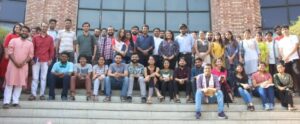
This blog provides discussion highlights for Sunday IR Cafe #13. Conducted on 22nd April 2022, the discussion covered Taking Love and Care Seriously: An Emergent Research Agenda for Remaking Worlds in the Wake of Violence.
CORE ARGUMENTS:
- Is there more to war than destruction? Can we understand the war on new terms differently than we already do? Krystalli and Schulz explore the possibility of a different understanding of war based on the themes of love and care, alongside death and destruction. Themes of love and care can be used as potential research sites for making sense of the world engulfed in violence. However, emotions are layered, and their political understanding poses certain ethical and narrative dilemmas in conceptualization.
- Love exists even amidst war and extreme human cruelty. The aim is to extend the research vision to provide an epistemic value to notions of love and care in the study of violence. The first step is to accept that the study of violence is a siamese twin to the study of peace. In this article, Roxani draws insights from her research on the politics and hierarchies of victimhood in Colombia, while Philipp’s research dealing with the lived realities of male sexual survivors in Northern Uganda also animates their conceptualisations.
- Enloe’s understanding of feminist sensibility informs this research project. The topics of love and care existed in the dialogue with the actors and survivors in conflict situations. These stories exist in the author duo’s exchanges with the survivors but were relegated to the sidelines in favour of addressing other research questions. This systemic erasure warrants introspection on the part of the scholars, as per the feminist sensibility.
- Our understanding of peace is narrow, based on individualistic and neoliberal considerations. Upon more serious consideration, we find a rather mixed picture of experiences of community and individuals in conflict-ridden zones, which includes love alongside the suffering. A new understanding of politics emerges with the accommodation of themes of love and care. These themes are as political as the themes of death and destruction in war. But the idea should be engaged without establishing a hierarchy between the predominant and contesting themes.
- The declaration of beginning or ending a war is a political process, but the normalisation after the war is very different at sites of violence. The government declares that the war has ended and that society has returned to normality, but the lived experience of people does not follow such a linear trajectory.
- What is love? In the author duo’s conception, love is not trapped in the heterosexual, romantic, and familial matrix. It’s a phenomenon that should be considered in the larger context of social relations and political spaces. Love is an active attribution of people toward the other; it has components of care, affection, recognition, respect, commitment, and trust. The practice of care is about making efforts to rebuild a wounded world. Love and care are two elements that go together in remaking a society, but they are not interdependent. There can be care without love, and care as a political tool can even be used to perpetuate violence and inequalities.
- The research is about expanding the vocabulary for the exploration of world politics. The research can not only be about counting the number of arsenals used and people who died or migrated but also about what those people felt, accounting for not only anger, shame, and humiliation but also love and care. The documentation of love often centres on the sexualized, materialised, and romanticised aspects. Rather, we need to account for how love is formed in people’s daily lives and affects their social and political interactions.
- An individual is not an atomized but a connected, interdependent, and situated being. Care is a universally required value and practice for all humans to survive. Still, care and love remain invisible in international relations. Politics of love and care can emerge as an alternative to the hegemonic field of conflict studies. Schulz’s and Krystalli’s study is a reminder of men’s emotional embrace and women’s political existence in the conflict zones. Love and care needed to be taken seriously in research while counting experiences of all genders and equally representing all themes of emotional engagements in conflict studies.
- The victims of violence in conflict zones shouldn’t be seen as a homogenous category. Also, their understanding varies according to the way interlocutors understand the concept of victimhood. The groups’ perception of their sorrow and misery often creates a hierarchy of victimhood which is then instrumentalised in making claims on the state and welfare organisations. Among themselves, the victim groups are vehicles of care and also a potential site for political mobilisation. Schulz’s work in Northern Uganda illuminates the sites of care among the male survivor groups. By creating local ecologies of resilience and bringing in a mechanism of societal healing, the attempt is made to localise care. Justice and care run as complimentary themes for these victim groups. The sites of care and its intermingling relation with justice and the hierarchies among and between the victim associations offer potential sites for research.
- It needs to be emphasised that caring is a work. Without this recognition, it becomes invisible both to the state and the communities engaged in it. These communities need support to continue their care work. Caring needs to be examined as work in a political setup to open up avenues of investigation into its practice in the wake of violence. The paper highlights the interpersonal aspects of care at a micro level that goes beyond organisations to include individuals. The individuals have the necessary role of a caregiver alongside navigating the bureaucracies for political compensation.
- One novel aspect of care work is seen in the stories of forced wives and abductees of the Lord’s Rebel army (LRA) in Uganda. The studies covering the LRA mostly focus on cruelty, killings, and gender-based violence. However, the internal dynamics of these violent groups are similar to an ordinary family living in a parallel society. The women provided support and care to other women in cases of childbirth, pain, and sickness. These stories show the complex simultaneity of care and violence. A sensible study of emotions in war requires illustrating and making evident both these aspects without romanticising or concealing one or another.
- Damage-centric research focuses only on the deprivation side, leaving a poodle of silence and ignorance to the acts and incidents of love, empathy, and care. The experiences of the ex-combatants present a different facet of conflict zones. Even in the face of war, love, respect, a sense of belonging, and a fraternal embrace persisted in those relationships among the combatants. The social bonding among the rebel combatants needs to be highlighted as part of an ethical, methodological commitment to research.
- The limitations of such a study emerge with the multiple meanings of the concepts of life and care. While the researcher might have a politicised sense of these in mind, policymakers see it in a way that depoliticizes these experiences. Another constraint emerges with the gendered targeting of victims and combatants. The stories of rape, sexual intercourse, menstruation, and romantic associations are targeted more instead of identifying the complete picture of their experiences. The female and the male participants are met with different questions; while women’s experiences in the personal domain take precedence in the research agenda, men are engaged for their worldview.
DISCUSSION:
- The attempt at turning love and care into a viable research topic in the IR discipline can be seen as worthy of appreciation. The paper effortlessly connects the understanding of war and death to the other side of human emotions that relate to the better angels of our nature. Most importantly, it questions the existing disciplinary boundaries by making space for ‘positive’ emotions in a discipline dominated by the discussions with an underlying moribund tone. The author duo’s noticeable contribution lies in defining and distinguishing love and care in order to operationalise them for further research. Still, their conception seemed short on clarity about elements that constitute love and care and the distinction between them. In this context, bell hooks’ idea of love and the distinction between love and care comes across as more substantial.
- The article compels us to think of conflict zones in more humane terms rather than solely focusing on violence and misery. It maintains that even working in this framework does not allow the stakeholders in conflict resolution to look away from building structures of peace. It attempts to give new vocabulary and space to these new dimensions of love and care and rescue them from gendered presuppositions.
- For some, the article succeeded in expanding the idea of what constitutes love and care. To understand it better, it makes sense to look at the Aristotelian idea of ‘zoon politikon’. In Aristotle’s conception, the political man is not separate from the social and economic spheres. The Zoon Politikon, thus, is in contrast with the modern idea of politics that concerns itself with human actions related to power and distribution of resources. Similarly, the author duo’s conception of love and care is not restricted to the narrow concern with a person, family, or community. Instead, their notion of love and care has an expansive horizon beyond the heteronormative, romantic, and anthropocentric focus, including other ways in which love and care are manifested.
- While not taking away the relevance of the article to the discipline of IR, the article drew criticism for its selection of case studies. For an article that seeks to deal with international relations, the case studies of Uganda and Colombia are concerned with building the world in the aftermath of a domestic, intrastate conflict. In response, it can be pointed out that the definitional boundaries of international relations themselves need not be taken for granted.
- In discussing the issue of love and care during conflict situations, an interesting parallel can be drawn with the Indian epics Mahabharata and Ramayana. In the Mahabharata, the death of Bhishma brings the entire war to a halt and reduces both the warring clans to tears in the Kurukshetra, showing a remarkable transition of the emotional landscape from that of bitter animosity to worry and care.
- The construction of a glorifying narrative that emphasizes fighting battles and dying in service of a cause as duty can be problematised through the idea of necropolitics. The idea goes that the state’s control over what counts as legitimate ways of living and dying comes to dictate the lives of citizens. Both Mbembé’s necropolitics and Agamben’s bare life highlight the logic of human life and death being used as a currency by the state. Through the instrumentalization of the self in service of the state, the individual existence is merely produced and reproduced without the concern for the flourishing of human life. In focusing on emotional narratives in the conflict zones that reveal the better part of our humanity, we can highlight the scope for escaping the worst of the necropolis and building an emancipatory world.

